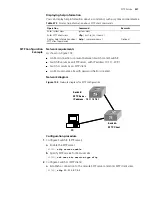
306
C
HAPTER
35: NTP C
ONFIGURATION
2
Configure S4200G 1.
a
Enter system view.
<S4200G>
system-view
System View: return to User View with Ctrl+Z.
[S4200G]
b
Enter VLAN interface 2 view.
[[S4200G]
interface vlan-interface 2
c
Configure S4200G 4 to be a multicast client.
[S4200G-Vlan-interface2]
ntp-service multicast-client
3
Configure S4200G.2
a
Enter system view.
<S4200G>
system-view
System View: return to User View with Ctrl+Z.
[S4200G]
b
Enter VLAN interface 2 view.
[[S4200G]
interface vlan-interface 2
c
Configure S4200G 1 to be a multicast client.
[S4200G-Vlan-interface2]
ntp-service multicast-client
The above configuration configures S4200G 1 to listen multicast packets through
their VLAN interface 2, and S4200G 3 to advertise multicast packets through VLAN
interface 2. Because S4200G 2 does not resides in the same network segment as
S4200G 3 does, the former cannot receive multicast packets sent by S4200G 3, while
S4200G 1 is synchronized to S4200G 3 after receiving multicast packets sent by
S4200G 3.
Display the status of S4200G 1 after the synchronization.
[S4200G]
display ntp-service status
Clock status: synchronized
Clock stratum: 3
Reference clock ID: 3.0.1.31
Nominal frequency: 250.0000 Hz
Actual frequency: 249.9992 Hz
Clock precision: 2^19
Clock offset: 198.7425 ms
Root delay: 27.47 ms
Root dispersion: 208.39 ms
Peer dispersion: 9.63 ms
Reference time: 17:03:32.022 UTC Thu Sep 6 2001 (BF422AE4.05AEA86C)
The output information indicates that S4200G 1 is synchronized to S4200G 3, with
the clock stratum being 3, one stratum higher than S4200G 3.
d
Display the information about the NTP sessions S4200G 1 and you can see that a
connection is established between S4200G 1 and S4200G 3.
[S4200G]
display ntp-service sessions
source refid st now poll reach delay offset dis
********************************************************************
[1]3.0.1.31 0.0.0.0 2 1 64 377 26.1 199.53 9.7
note: 1 source(master),2 source(peer),3 selected,4 candidate,5
configured
Summary of Contents for 4200G 12-Port
Page 10: ...8 CONTENTS...
Page 14: ...4 ABOUT THIS GUIDE...
Page 46: ...32 CHAPTER 5 LOGGING IN THROUGH WEB BASED NETWORK MANAGEMENT SYSTEM...
Page 48: ...34 CHAPTER 6 LOGGING IN THROUGH NMS...
Page 60: ...46 CHAPTER 9 VLAN CONFIGURATION...
Page 64: ...50 CHAPTER 10 MANAGEMENT VLAN CONFIGURATION...
Page 80: ...66 CHAPTER 13 GVRP CONFIGURATION...
Page 98: ...84 CHAPTER 15 LINK AGGREGATION CONFIGURATION...
Page 112: ...98 CHAPTER 18 MAC ADDRESS TABLE MANAGEMENT...
Page 126: ...112 CHAPTER 19 LOGGING IN THROUGH TELNET...
Page 162: ...148 CHAPTER 20 MSTP CONFIGURATION...
Page 274: ...260 CHAPTER 29 IGMP SNOOPING CONFIGURATION...
Page 276: ...262 CHAPTER 30 ROUTING PORT JOIN TO MULTICAST GROUP CONFIGURATION...
Page 298: ...284 CHAPTER 33 SNMP CONFIGURATION...
Page 304: ...290 CHAPTER 34 RMON CONFIGURATION...
Page 338: ...324 CHAPTER 36 SSH TERMINAL SERVICES...
Page 356: ...342 CHAPTER 38 FTP AND TFTP CONFIGURATION...
Page 365: ...Information Center Configuration Example 351 S4200G terminal logging...
Page 366: ...352 CHAPTER 39 INFORMATION CENTER...
Page 378: ...364 CHAPTER 40 BOOTROM AND HOST SOFTWARE LOADING...
Page 384: ...370 CHAPTER 41 Basic System Configuration and Debugging...
Page 388: ...374 CHAPTER 43 NETWORK CONNECTIVITY TEST...
Page 406: ...392 CHAPTER 45 CONFIGURATION OF NEWLY ADDED CLUSTER FUNCTIONS...
















































